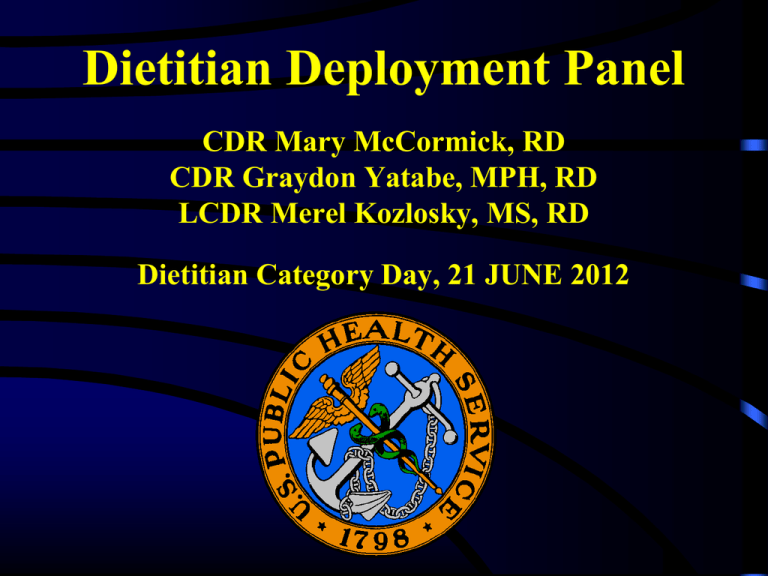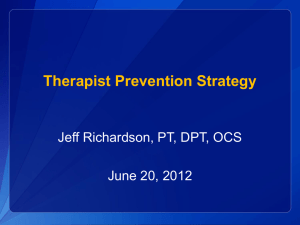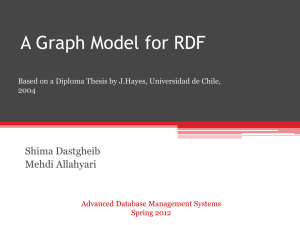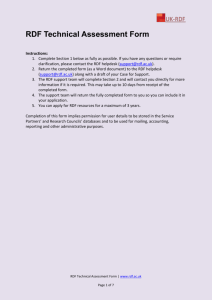Presentation - PHS Commissioned Officers Foundation for the
advertisement

Dietitian Deployment Panel CDR Mary McCormick, RD CDR Graydon Yatabe, MPH, RD LCDR Merel Kozlosky, MS, RD Dietitian Category Day, 21 JUNE 2012 Objectives • Summarize structure, make-up, and missions of Commissioned Corps response teams. • Describe deployment roles for dietitians and the value of dietitians on deployment teams. • Identify skills and professional growth opportunities that can be gained from deployments. RDF Rapid Deployment Force LCDR Merel Kozlosky, MS, RD RDF – Facts and Figures • • • • Tier 1 team 5 RDF teams 125+ officers per team Scalable – Can divide into smaller subunits – Can be augmented with Tier 3 officers • • • • Deploy within 12 hrs of activation On-call 1 out of every 5 months Deployments typically do not exceed 2 wks Up to 2 wks of response team training per yr RDF - Primary Activity Areas • Mass care (primary care, mental health, and public health services for sheltered populations) • Point of distribution operation (mass prophylaxis and vaccination) • Medical surge • Isolation and quarantine • Pre-hospital triage and treatment • Community outreach and assessment RDF - Primary Activity Areas • • • • Humanitarian assistance On-site incident management Medical supplies management and distribution Public health needs assessment and epidemiological investigations • Worker health and safety • Animal health emergency support RDF - Structure • • • • • Command Planning Section Admin/Finance Section Logistics Section Operations Section – – – – Medical Services Branch Pharmacy Branch Preventive Medicine Branch Ancillary Services or Intake, Consult, and Discharge Branch RDF – Rosters as of 1 APR 2012 • RDF #1 = 3 RDs – LCDR Kozlosky, LCDR Mero, LT Blood • RDF #2 = 3 RDs – CDR Fitzpatrick, LCDR Digennaro, LCDR Wolcoff • RDF #3 = 1 RD – CDR Frost • RDF #4 = 3 RDs – CAPT Sipe, CDR Banks, LCDR Kim • RDF #5 = 5 RDs – CDR Little, CDR Moser, LCDR Interpreter, LCDR Mahrt, LT Holliday RDF – Personal Experience • Preventive Medicine Branch Director (2009 – Present) • Food Safety/Nutrition (2006 – 2009) • RDF Deployments – Operation Lone Star (2011) – Inauguration (2009) – Hurricane Ike – FMS College Station (2008) – Independence Day on the Mall (2008) • RDF Training – State of Tennessee and Metro Nashville Public Health Departments (2010) – Fort AP Hill (2009) – RDF Response Team Workshop (2006) Hurricane Ike – FMS College Station Hurricane Ike – FMS College Station Operation Lone Star • • • • Rio Grande Valley in Texas Serving medically underserved and vulnerable population Non-disaster / non-emergency setting Split RDF team into 4 sites Operation Lone Star – Nutrition Counseling and Wellness Center Operation Lone Star – Epidemiology Project • Multi-disciplinary – Epidemiologists, Dietitian, Admin/Finance, Local Volunteers • Data collection – Household survey – Medical record data • Reports Home away from home… RDF - Gains • Team training – Hone disaster response skills – Know who you will deploy with – Increases comfort level of deployment • Expanded skill sets – Clinical and Food Service – Epidemiology – Preventive Medicine • Leadership opportunities • Networks and collaborations • Upholding mission to protect, promote, and advance the health and safety of our Nation APHT Applied Public Health Team CDR Graydon Yatabe, MPH, RD APHT - Team Structure and Function The goals of APHTs are to: 1. Assist a community and its officials to reestablish essential public health services when local resources are overwhelmed or disrupted, and 2. Support and augment local, state, territorial, tribal, or international health programs in providing public health services for affected populations and emergency response workers. APHT - Team Structure and Function • Tier Two • Response Time: 36 hours • Approximately 50 Officers per team (not regional teams) – – – – Multi disciplinary staffing including Command Staff One team on-call each month Pre-event, response and/or recovery missions Mirror and support local health department programs APHT - Team Structure and Function • Scalable response – Deploy only what is needed based on Mission Assignment – Team structure grows/shrinks to address need • Augmentable – Subject matter experts APHT - Team Structure and Function APHT Command Staff Epidemiology Surveillance Group Environmental Public Health Group Preventive Services Delivery Group APHT - Team Structure and Function • Epidemiology and Surveillance Group – Data collection and data analysis – Community health status profile – Contact tracing • Preventive (Medical) Services Group – – – – Health statistics information dissemination Vaccinations Public health or medical education & recommendations Alert or advise local providers, officials, & public APHT - Team Structure and Function • Environmental Health Group – – – – Adequate and safe water supply Availability of safe, nutritious food Access to adequate shelter Environmental & occupational hazard assessment APHT - Team Structure and Function Command Commander Deputy Commander Liaison Officer IT Personnel Safety Officer Preventive Services Delivery Group Physician (preventive or occupational medicine) Public Health Nurse or Practitioner Health Educator Epidemiology/Surveillance Group Epidemiologist Environmental Health Group Industrial Hygienist Disaster Response Engineer Environmental Health Food Safety Inspector Hazardous and Solid Waste Consultant Veterinarian SAT, MHT NIST, RIST, CAP CHASM CDR Mary McCormick, RD Services Access Team (SAT) (2006) • Tier 2 – deploy within 36 Hours, typically for up to 2 weeks • Comprised of 10 USPHS officers, although more or less may deploy, as needed • Functions Needs assessment Clinical care coordination Transition management & re-integration New role: coordinate patient movement (ASPR) Mental Health Team (MHT) (2006) • Tier 2 – deploy within 36 Hours, typically for up to 2 weeks • Comprised of 26 USPHS officers, although more or less may deploy, as needed • Functions Needs assessment & treatment Screening – suicide risk, stress reactions, substance abuse, etc. Specialized counseling Psychological first aid, crisis intervention National Incident Support Team (2009) • Tier 1 – deploy within 12 hours, up to 2 weeks • Comprised of 72 USPHS officers, although more or less may deploy, as needed • Functions Ongoing event needs assessment Support & direction for incoming response assets Liaison with State, Tribal & local officials On-site incident management Demobilization support Regional Incident Support Team (2009) • Tier 1 – deploy within 12 hours, usually 1-3 days, NTE 30 days/year • Comprised of 12 - 30 USPHS officers, although more or less may deploy, as needed • Functions Rapid event needs assessment Support & direction for incoming response assets Liaison with State, Tribal & local officials On-site incident management Capitol Area Provider Team • Tier 2 – deploy within 36 Hours, typically <3 days • Comprised of 5 USPHS officers • Augment the Office of the Attending Physician (OAP); deploy only in support of NCR events • Functions First responder & primary care, BLS, ACLS Pre-hospital triage & treatment Point-of-distribution operation (i.e. – vaccination) Medical surge On-site incident management Community Health and Service Missions CHASM • • • • • • WHAT (concept) WHAT (services rendered) WHO HOW WHERE WHEN 2010 – Operation Nexus 2011 – Operation Foothold 2012 – 2 missions planned Interactive Q&A • Questions about deployment teams? • Barriers to being on deployment teams? • What can the Dietitian PAC Readiness Subcommittee do to support you? For more information, see Response Team Fact Sheets at… http://ccrf.hhs.gov/ccrf/current%20teams.htm











